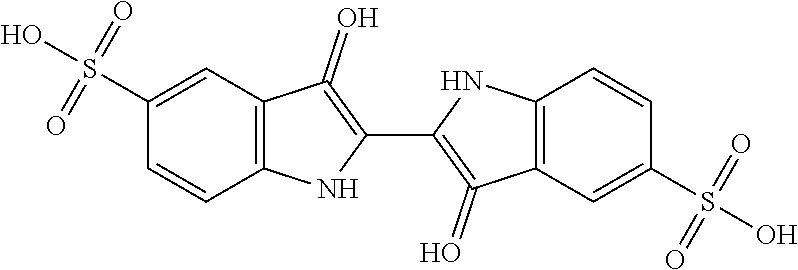Process for preparing indigo carmine
a technology of indigo carmine and process, which is applied in the field of indigo carmine preparation, can solve the problems of inability to separate, disulfonated isomers, and introducing undesired contaminants into the patient's body,
- Summary
- Abstract
- Description
- Claims
- Application Information
AI Technical Summary
Benefits of technology
Problems solved by technology
Method used
Image
Examples
Embodiment Construction
[0035]Step i): Sulfonation of Indigo
[0036]The starting material is indigo or 2-(1,3-dihydro-3-oxo-2H-indole-2-ylidene)-1,2-dihydro-3H-indole-3-one (CAS: 482-89-3). Indigo is subjected to a sulfonation
treatment according to scheme 2 below:
[0037]Scheme 2: Sulfonation Reaction of Indigo
[0038]This known reaction is usually performed by treatment with sulfuric acid. Reference may be made, for example, to the following publications: US-647280; Tudora Baltac et al., Revista de Chimie (Bucharest, Romania) (2012), 63(6), 618-620; Iqbal T. Shadi et al., Chemical Communications (Cambridge, United Kingdom) (2004), (12), 1436-1437; Capron, F. (1863), Blues and carmines of indigo: a practical treatise on the fabrication of every commercial product derived from indigo; Philadelphia: H. C. Baird (https: / / catalog.hathitrust.org / Record / 006218585); Vanessa Bianda et al., Bulgarian Journal of Science Education, Volume 22, Number 1, 2013; Charles E. Carraher et al., Journal of Macromolecular Science, Vo...
PUM
| Property | Measurement | Unit |
|---|---|---|
| temperature | aaaaa | aaaaa |
| temperature | aaaaa | aaaaa |
| pH | aaaaa | aaaaa |
Abstract
Description
Claims
Application Information
 Login to View More
Login to View More - R&D
- Intellectual Property
- Life Sciences
- Materials
- Tech Scout
- Unparalleled Data Quality
- Higher Quality Content
- 60% Fewer Hallucinations
Browse by: Latest US Patents, China's latest patents, Technical Efficacy Thesaurus, Application Domain, Technology Topic, Popular Technical Reports.
© 2025 PatSnap. All rights reserved.Legal|Privacy policy|Modern Slavery Act Transparency Statement|Sitemap|About US| Contact US: help@patsnap.com



